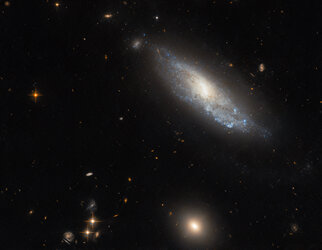

Cosmic fireworks
This NASA/ESA Hubble Space Telescope Picture of the Week features the galaxy NGC 6984, an elegant spiral galaxy in the constellation Indus roughly 200 million light-years away from Earth. The galaxy is a familiar sight for Hubble, having already been captured in 2013. The sweeping spiral arms are threaded through with a delicate tracery of dark lanes of gas and dust, and studded with bright stars and luminous star-forming regions.
These new observations were made following an extremely rare astronomical event — a double supernova in NGC 6984. Supernovae are unimaginably violent explosions on a truly vast scale, precipitated by the deaths of massive stars. These events are powerful but rare and fleeting — a single supernova can outshine its host galaxy for a brief time. The discovery of two supernovae at virtually the same time and location (in astronomical terms) prompted speculation from astronomers that the two supernovae may somehow be physically linked. Using optical and ultraviolet observations from Hubble’s Wide Field Camera 3, astronomers sought to get a better look at the site of the two supernovae, hopefully allowing them to discover if the two supernova explosions were indeed linked. Their findings could give astronomers important clues into the lives of binary stars.
As well as helping to unravel an astronomical mystery, these new observations added more data to the 2013 observations, and allowed this striking new image to be created. The observations — each of which covers only a narrow range of wavelengths — add new details and a greater range of colours to the image.





